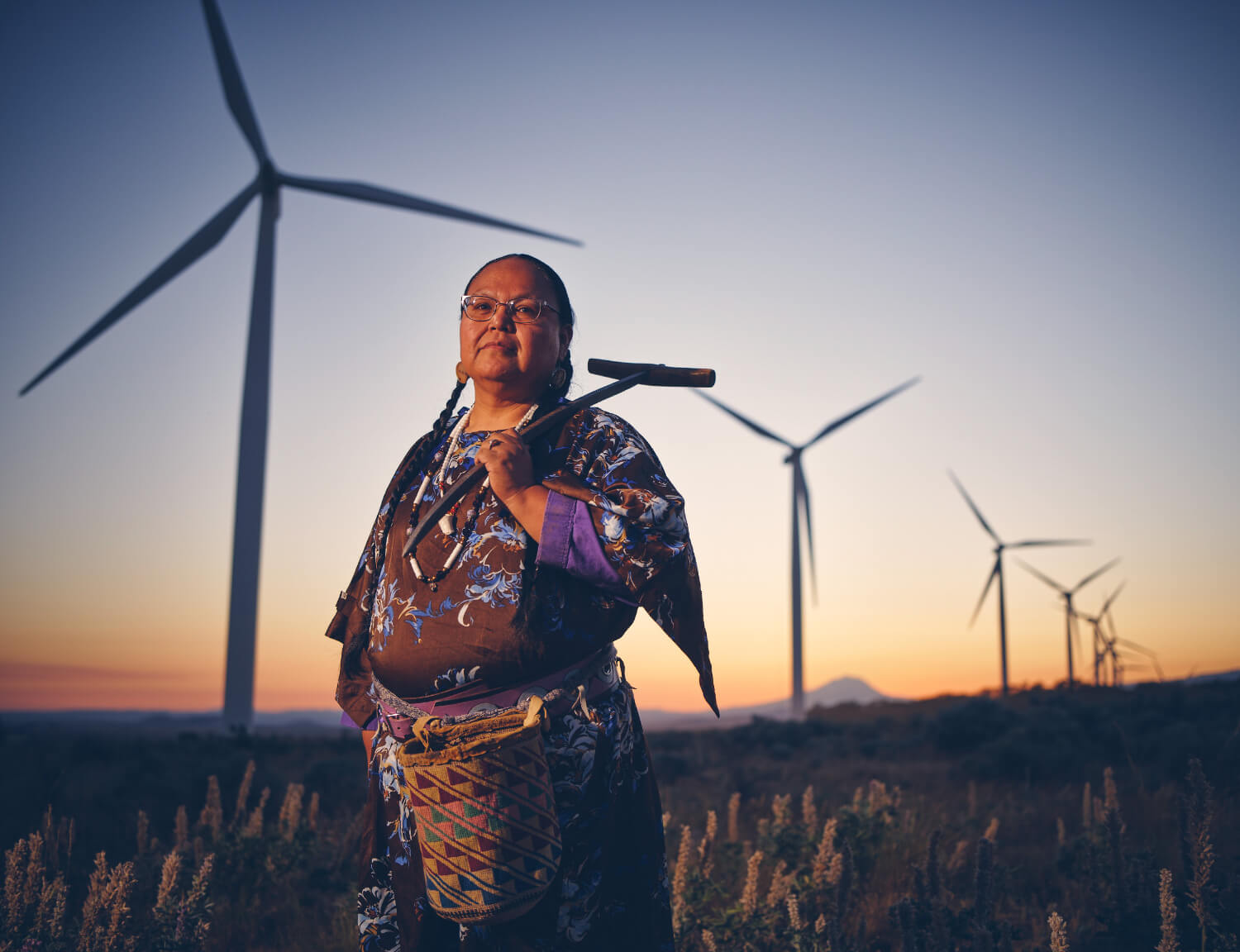Three viewpoints: A proposal to lay cables beneath the Columbia River is met with skepticism from an Indigenous activist and the river’s advocates.
 Can slicing a 100-mile-long trench into the bed of the Columbia River — the iconic giant whose flow binds British Columbia, Washington and Oregon — be good for the environment? The answer is a big yes, says a team of energy developers that proposes submerging power cables in the riverbed.
Can slicing a 100-mile-long trench into the bed of the Columbia River — the iconic giant whose flow binds British Columbia, Washington and Oregon — be good for the environment? The answer is a big yes, says a team of energy developers that proposes submerging power cables in the riverbed.
The developers say the submerged cables could deliver “clean” energy that will be crucial for getting the most densely developed areas of Cascadia off fossil fuels.
A proposal by renewable energy developer Sun2o Partners and transmission developer PowerBridge would insert the cables into the Columbia at The Dalles in Oregon. This electrical on-ramp is near the towering wind farms and expansive solar farms installed along the Columbia Gorge in eastern Oregon and Washington.
The cables also would intersect and plug into the monster transmission lines at the Bonneville Power Administration’s Big Eddy substation, drawing cheaper solar power from the Southwest, steadier wind power from Montana and Wyoming, and reliable backup power from British Columbia’s supersized hydropower reservoirs.
But even climate-conscious developers can’t make plans involving a natural resource like the Columbia River without causing uneasiness among those concerned with ecosystems and communities. Along the Columbia, those affected would include tribal nations and unique cultural interests.
Regulators and environmentalists are likely to find themselves caught in the middle — wanting environmental justice for tribal nations, as well as limits to the impacts of energy projects on ecosystems, yet also eagerly seeking rapid action on projects designed to slow climate change.
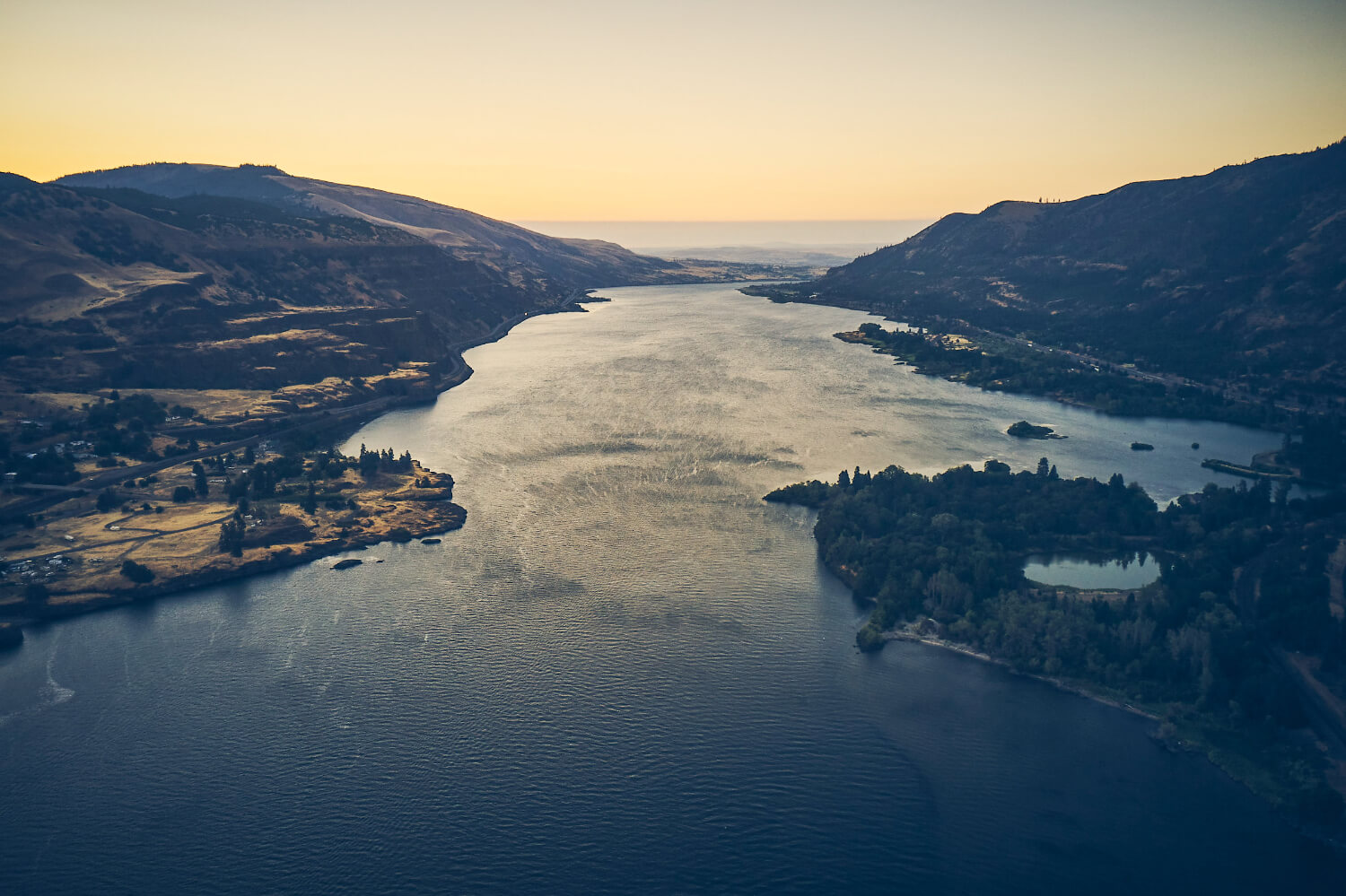
Wind etches the Columbia River’s surface downstream of Squally Point, at right in the distance. Around the bend lies The Dalles, where Cascade Renewable Transmission partners propose to start laying power cables in the riverbed. The cables would deliver enough renewable energy to Portland to power nearly 1 million homes. (Photo: Leah Nash)
Sun2o and PowerBridge propose to bring their cables ashore in Portland, helping to electrify industries, buildings and vehicles while reducing the use of coal- and gas-fired power plants. Hence the project’s name: Cascade Renewable Transmission.
“The only places you can site solar and wind at scale are, for the most part, east of the Cascades. But the demand, the need for the electricity, is in Portland and Seattle, on the west side,” says Corey Kupersmith, the New York–based renewable energy developer who cofounded Sun2o and dreamed up the cable scheme. And existing power lines that link east and west are filling up fast, he says.
Anticipating environmental concerns, the developers assert they will do little harm to the Columbia, employing high-pressure pumps that make underwater cable installation quick and not so dirty. Powerful water jets would shoot down from a “hydroplow” towed along the Columbia riverbed, stirring open an 18-inch-wide trench in the sediment, while operators on the ship observe and make adjustments. A bundle of cable, unspooling as the plow moves, would slip into the trench and be buried as fluidized sediment settles back down.
Environmental impacts, they argue, would likely be short-term and outweighed by anticipated environmental gains: reductions in pollution from [su_tooltip position=”north” shadow=”yes” size=”2″ title=”Natural gas” content=”A gaseous fossil fuel primarily composed of methane. Supply expanded in the U.S. and Canada with the introduction of hydraulic fracturing or ‘fracking’, a production method that shatters underground rock formations to release gas trapped within pores in the rock. Natural gas served as a ‘bridge fuel’ by serving as a substitute to dirtier coal-fired power plants. But with climate goals tightening the pressure is on to replace natural gas with renewable energy.”][su_highlight background=”#ffeb1c”]natural gas,[/su_highlight][/su_tooltip] petroleum fuels and coal. That includes emissions of carbon dioxide and methane, two of the [su_tooltip position=”north” shadow=”yes” size=”2″ title=”Greenhouse gas emissions” content=”Greenhouse gas emissions: Releases of gases that trap heat in Earth’s atmosphere, thereby altering its climate. Greenhouse gases include carbon dioxide associated with fossil fuel combustion, methane associated with natural gas leaks and agriculture, and fluorocarbon chemicals used in industrial processes and air conditioners.”][su_highlight background=”#ffeb1c”]greenhouse gases[/su_highlight][/su_tooltip] that are supercharging Cascadia’s wildfires and heat waves and disrupting even the mighty Columbia’s temperature and timing.
To Elaine Harvey, however, the Cascade Renewable Transmission pitch sounds like one more industrial enterprise in a seemingly endless stream of projects that have harmed her people. Such ventures have decimated the Columbia River’s fisheries and fenced off and degraded the shrub-steppe grasslands that the Yakama and other tribes and bands ceded in an 1855 treaty with the United States.
A member of the Yakama’s Kah-milt-pa, or Rock Creek, Band, Harvey lives with the legacy of dams, aluminum production, wind farms, expanding solar plants and other development. Each has infringed her people’s right to pursue their traditional practices.
As Harvey and Kah-milt-pa Chief Bronsco Jim Jr. wrote earlier this year in the quarterly newsletter of Columbia Riverkeeper: “Ours is a living culture, and we are being cheated by progress. An unrelenting cultural extinction in the name of energy development.”
The Cascade link is one of several power lines proposed or under construction in Washington, Oregon and British Columbia. And those are part of a larger trend across the United States and Canada, and around the world.
Power-system experts say the grid that has sufficed in the fossil-fuel era must increase capacity if renewable electricity is to become the lifeblood of economies. Most regional and national [su_tooltip position=”north” shadow=”yes” size=”2″ title=”Decarbonization” content=”To shift away from energy sources and uses, such as fossil fuels, that release carbon dioxide and methane. Those carbon-based greenhouse gases are responsible for roughly four-fifths of human-caused climate change.”][su_highlight background=”#ffeb1c”]decarbonization[/su_highlight][/su_tooltip] studies identify beefier grids that share power over longer distances as a precondition to weaning economies off fossil fuels.
Wind blows and sunlight shines most reliably in places that are sparsely populated — areas with weak power lines. Stronger grids, in contrast, enable more power to travel between regions, so those areas can help each other out — precisely what Texas couldn’t do when a deep freeze brought the state to its knees in February and when heat strained its grid last month.
To explore the role of power transmission and the tradeoffs involved in grid expansion, InvestigateWest spoke with Kupersmith, Harvey and Lauren Goldberg, the legal and program director for Columbia Riverkeeper.
Corey Kupersmith: Renewable energy developer
An early passion for diving exposed Corey Kupersmith to coral bleaching resulting from water pollution and global warming. An engineer by training and a banker by trade, Kupersmith cofounded New York City–based Sun2o with a colleague five years ago as a business venture that honors his environmental values. “We only work on projects that reduce emissions and create a positive impact,” says Kupersmith.
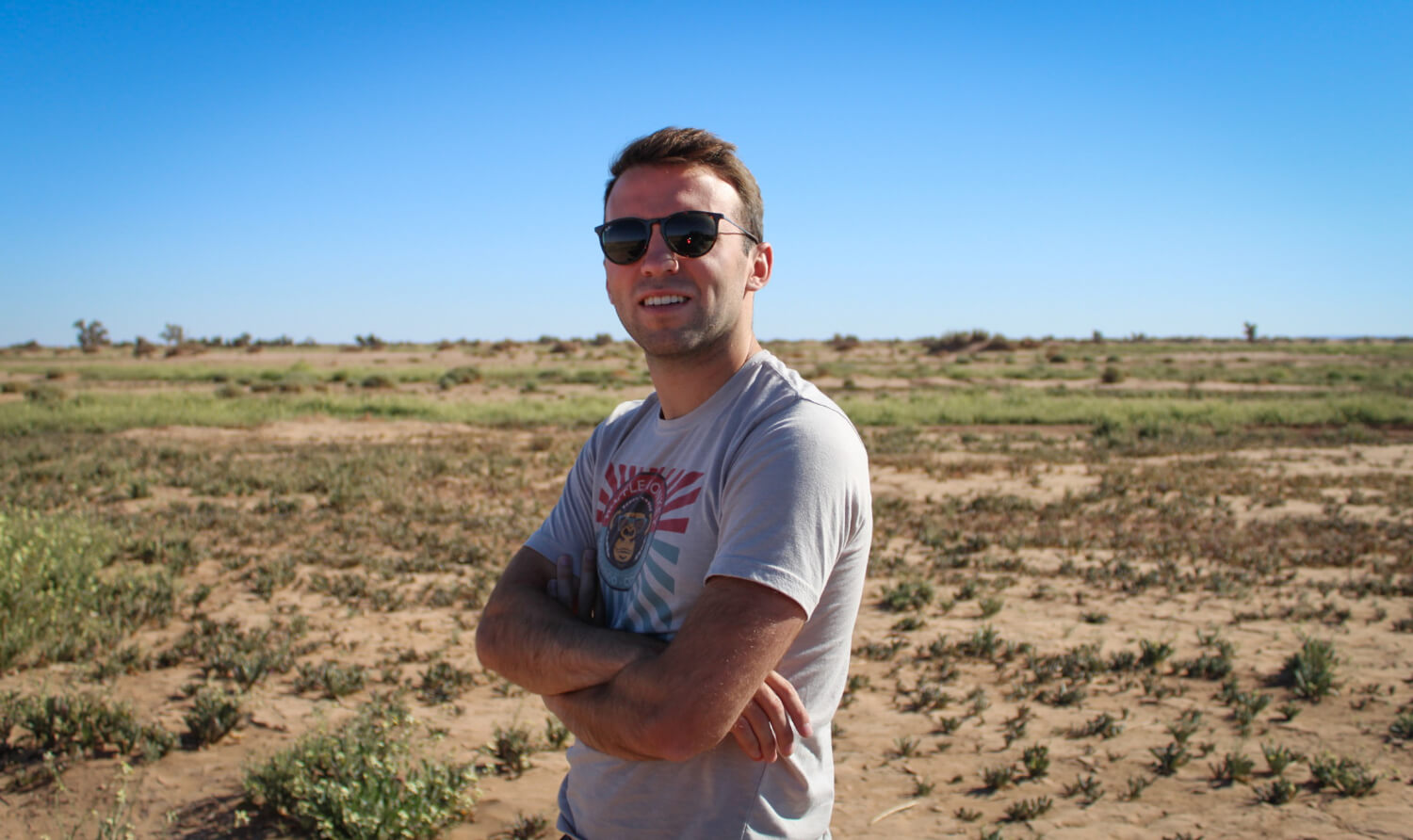
Corey Kupersmith says the grid must expand fast to deliver the renewable electricity that Oregon and Washington needs to decarbonize. He bets that burying cables out of sight in the Columbia’s riverbed will skirt ‘not-in-my-backyard’ community opposition that delays or blocks new overhead power lines. (Photo provided by Kupersmith)
Pursuing solar energy projects in sun-soaked eastern Oregon and Washington inspired him to propose the Cascade link project. Sun2o found plenty of landowners and rural communities eager to host arrays of solar panels. But it struggled to secure affordable space on power lines so it could send that energy to the utilities in greatest need of renewable energy. Those include Puget Sound Energy, the investor-owned firm that serves northwestern Washington, and Portland General Electric, Oregon’s largest investor-owned utility.
Instead, Sun2o is moving forward with smaller projects in eastern Washington and Idaho, serving utilities east of the coastal mountains, such as Spokane-based Avista Utilities.
Moving power west over the Cascades means getting access to the Bonneville Power Administration’s (BPA) regional network, the U.S. Northwest’s transmission backbone. That network is maxing out as a wave of renewable power projects plug in, along with the battery plants needed to store and release power to help keep grid supply and demand in balance. “BPA has like 28 gigawatts of solar, wind and storage requests,” says Kupersmith. “That’s going to be pushing systems to their limits.”
And that was before Oregon passed one of North America’s most aggressive grid decarbonization plans. The June bill, which Gov. Kate Brown is expected to sign into law this month, requires Oregon’s investor-owned utilities to deliver 80% carbon-free power by 2030, compared to less than 50% today. It mandates 100% carbon-free electricity by 2040 — five years ahead of deadlines set by Washington state and California.
Bonneville itself is in a tough spot. The federal entity is being financially stretched by rising costs to maintain aging dams and improve impacted salmon fisheries and decreasing revenues due to falling power prices and customers defecting to cheaper suppliers.
Hitting a transmission barrier in his own developments inspired Kupersmith to propose the Cascade cables. He knew putting them in the riverbed was an option, because PowerBridge had installed two transmission lines in the Hudson River near Manhattan to ease power bottlenecks in New York City and on Long Island. And he saw a submerged cable as an end-run around opposition to overhead lines that has scuppered previous grid expansion efforts in Cascadia and frequently ties up projects across the continent. Overhead lines have drawn the ire of both communities and conservationists.
Kupersmith’s partner at PowerBridge, Chris Hocker, its vice president of planning, calls overhead lines “hideously problematic,” noting that they can take a decade or more to build. In contrast, he and Kupersmith anticipate their cables in the Columbia would begin pumping electricity through the Columbia in just five years — lightning speed for new transmission.
Of course, that depends on government and community approval. The partners have requested studies of the project’s necessity from Portland General Electric as well as Northern Grid, an alliance of Northwest utilities that coordinates regional transmission planning.
And the partners recently have begun conversations with the four tribes that have treaty rights in the region, including the Yakama Nation and the Cowlitz Indian Tribe. Kupersmith says they had hoped to start meeting earlier but were delayed by the pandemic and a desire to conduct the consultations in person.
Elaine Harvey: Kah-milt-pa activist
For Elaine Harvey, a power line in the Columbia heading west from The Dalles would be yet another to add to a pile of damaging energy developments taking place over decades. One of the most devastating was the 1957 completion of The Dalles Dam — one of 14 major dams on the Columbia’s main stem responsible for generating more than half of the Northwest states’ power – and decimating the world’s largest fishery.
The Dalles Dam energized the associated Big Eddy substation, where Kupersmith and his partners hope to plug into BPA’s regional grid, and which has its own painful associations for local tribes.
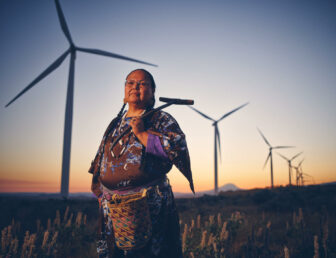
Standing before a row of the more than 2,900 industrial-scale wind turbines that tap the gales funneling through the Columbia River Gorge, Elaine Harvey poses for a portrait holding a ka’pin, a traditional tool for digging edible and medicinal roots. The turbines supply low-carbon electricity, but Harvey says they’ve also brought fences and ‘no trespassing’ signs to her band’s traditional lands, excluding her people from native plant harvesting areas. At this location, there is only one landowner who allows her band to gather foods for ceremonial and subsistence purposes. (Photo: Leah Nash)
The Dalles Dam’s 200-foot-high barrier submerged the storied Celilo Falls, where daring dip netters once caught leaping salmon and steelhead. The dam also submerged a complex of villages nearby, which had been a gathering point for traders from tribes across the Northwest. Prior to the dam, it was North America’s oldest site of continuous human habitation.
And power lines running 7 miles from Big Eddy to Chenoweth, just west of The Dalles, pass over an Indigenous burial site.
Emotions from those historic insults and numerous other losses remain fresh more than half a century later, as Indigenous communities continue to grapple with a settler culture that often seems incapable of hearing their concerns.
Harvey sees that inability manifested in another proposed grid reinforcement project that she’s fighting, just upstream from The Dalles. The Goldendale Energy Storage Project would build a pair of 60-acre reservoirs, one alongside the river and one on a bluff above. By moving Columbia River water between the reservoirs, the project would store and discharge energy like a giant battery.
The project faces vocal opposition from the Yakama Nation, to whom the site is profoundly sacred. Yakama stories recall the bluffs as a haven during great floods in millennia past, and Harvey says her band still forages there for culturally important “first foods,” such as desert parsley.
They already have lost much access to foraging sites because of wind farms, which have fenced off large areas. Only one landowner hosting a wind farm in the area allows Harvey’s people to enter and gather traditional plants, she says. Meanwhile, explosive solar development threatens to kill native plant habitat, she says, unless consultation improves between developers, government agencies and tribes.
Recently, there have been instances of better consultation. For example, at the urging of the Yakama, BPA adjusted the route of a short transmission line added to Big Eddy in 2015. In contrast, Harvey points to Washington Gov. Jay Inslee’s line-item veto that removed a requirement for the state to consult with tribes on environmentally sensitive projects — a requirement legislators had included in the state’s recently passed carbon [su_tooltip position=”north” shadow=”yes” size=”2″ title=”Carbon cap and trade” content=”A mechanism for controlling carbon pollution whereby governments set a cap on emissions that declines annually, and require polluters to buy credits for every ton of carbon pollution they release. The carbon credits, often acquired via auctions, can be traded on carbon markets. Cap and trade systems create a financial incentive to reduce pollution, but they can also disadvantage vulnerable communities without careful policy design.”][su_highlight background=”#ffeb1c”]cap-and-trade[/su_highlight][/su_tooltip] law.
Harvey asks whether the onslaught of development in the Columbia Gorge is necessary. She questions whom the projects are really intended to benefit, noting with suspicion the express line running between BPA’s Big Eddy hub and Los Angeles.
The express line and others were built in the 1960s to help power California. In the future, excess solar power could flow north when the sun is up. But today, the lines’ primary use remains the shipment of hydropower from the Columbia River dams and British Columbia south to California.
Harvey wants to know where development will stop. “What I’m concerned about is: What is this going to lead to? Is this going to lead to wind [turbines] down the middle of the river? What’s down the line?”
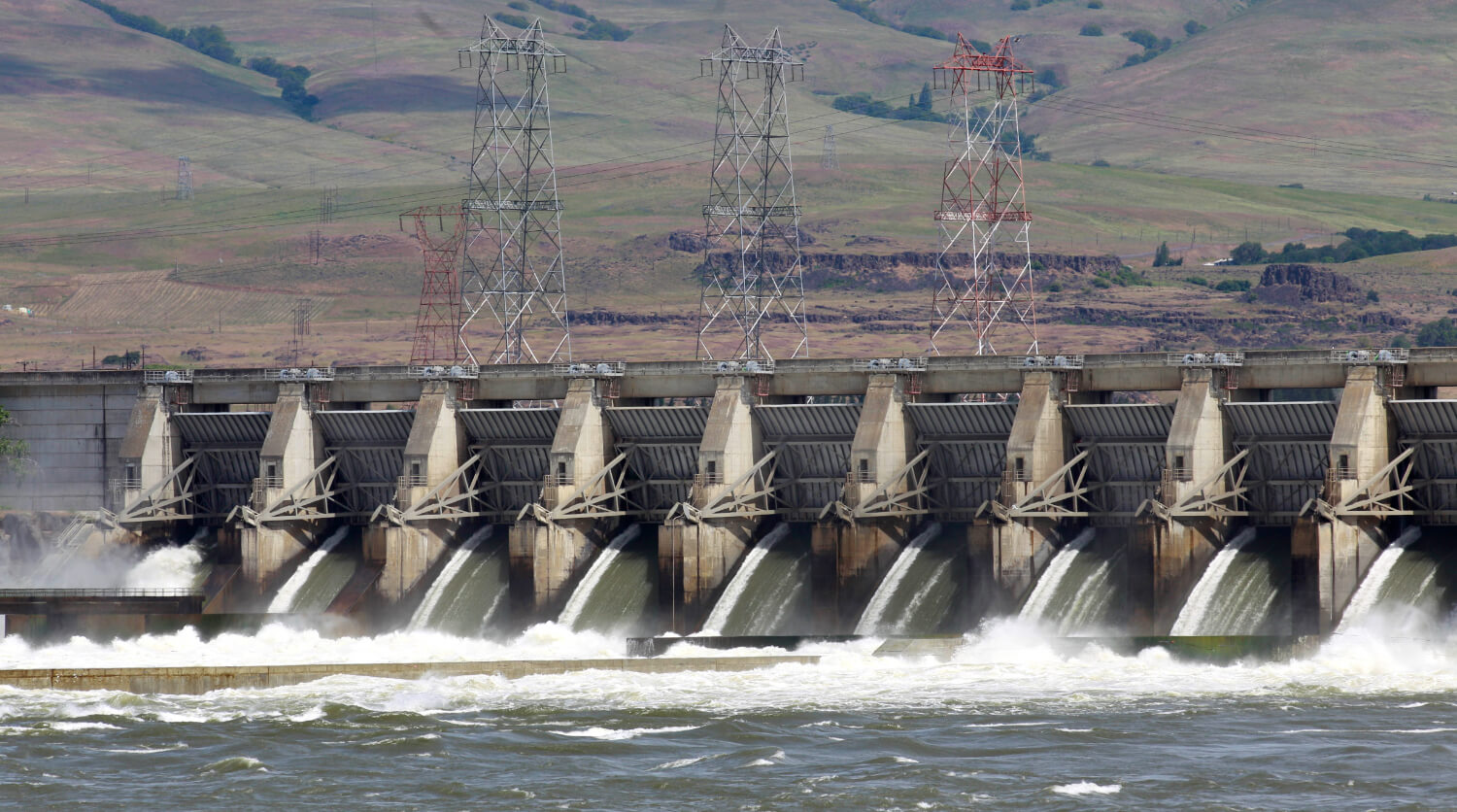
The Dalles Dam and other hydroelectric power stations on the Columbia wreak ecological havoc by slowing water, blocking fish, and raising water temperatures. But they are also seen as a powerful enabler of renewable energy. Their turbines can run at times of low wind and solar power generation, smoothing out the overall supply of renewable energy. (Photo: AP)
Climate change also worries Harvey. A biologist by training, she knows that warmer water represents a growing threat to the Columbia’s struggling fisheries, including bottom-feeding suckerfish and sturgeon.
Harvey thinks other solutions need to be considered. Solar and wind farms are not the only ways to cut carbon pollution, she says. Gas-fired power plants can be equipped to capture the CO2 they produce. Smarter logging practices and coastal protections can boost the ability of inland forests and kelp forests to capture atmospheric CO2. Rooftop solar panels can generate power where it’s needed most.
Bottom line, says Harvey: “We already gave up enough.”
Lauren Goldberg: River defender and lawyer
For Lauren Goldberg, projects like the proposed Cascade cables can present an acute challenge. Goldberg, a 15-year veteran at Columbia Riverkeeper, sees fossil fuels and climate change as existential threats to the river and the communities that rely on it. This is a reason Riverkeeper has been a mainstay in the “Thin Green Line” movement that has blocked many efforts to push more coal, oil and liquefied natural gas down the rail lines transiting the Gorge.
And it’s why it has advocated for more clean energy production. “The Columbia River is already being impacted by the climate crisis, and the projections are dire,” says Goldberg.

Lauren Goldberg says the Columbia Riverkeeper sees an ongoing risk of new power lines enabling expanded gas-fired generation in Cascadia, in spite of the region’s ambitious carbon-cutting mandates. She says Oregon’s new power sector decarbonization law, for example, does not preclude construction of new gas plants to power industries such as Bitcoin ‘mines.’ (Photo: Leah Nash)
Goldberg says a lot of green energy development has happened in the Columbia Basin, and she expects that will continue. But that does not mean every project that calls itself renewable and green gets a pass.
Cascade Renewable Transmission’s proponents, says Goldberg, must first prove that their project lives up to its name. “One of our core questions is ‘What power is this moving?’”
Goldberg notes that energy developers want to build a new gas-fired power plant, dubbed the Perennial Wind Chaser, east of The Dalles. They have secured a site certificate from Oregon. And gas developments have been endorsed by some energy experts who see generators burning a fossil fuel such as gas today, then transitioning to a cleaner fuel, such as renewable [su_tooltip position=”north” shadow=”yes” size=”2″ title=”Green hydrogen” content=”Hydrogen gas is currently made primarily from fossil natural gas, a process that’s responsible for about 3% of global CO2 emissions. But hydrogen can also be produced by sending electric current from renewable power plants through water. Such ‘green hydrogen’ is a combustible, renewable fuel that is easier to store than wind and solar electricity, providing a reliable supply of zero-carbon energy. Green hydrogen can replace coal, gas and petroleum fuels in heavy industry and vehicles. It can also fuel power plants to generate electricity during extended periods of weak sunlight and winds. See this Q&A for a critical exploration of hydrogen’s potential and challenges, including concerns that growing hydrogen demand will spur increased production from natural gas. “][su_highlight background=”#ffeb1c”]hydrogen[/su_highlight][/su_tooltip] as a crucial source of backup power.
Proponents of the Cascade link say they have no relationship with individual power projects, and that the utility planners are evaluating what role their project would play in meeting the region’s clean energy policy goals.
Even if the power cables are deemed important for the energy transition, for Goldberg their carbon-cutting potential must outweigh their direct environmental impacts.
“We’ve got a lot of questions and a lot of concerns. Whether it’s renewable energy or fossil energy, we need to understand how a project is going to impact people that rely on the Columbia for salmon and for clean water,” says Goldberg.
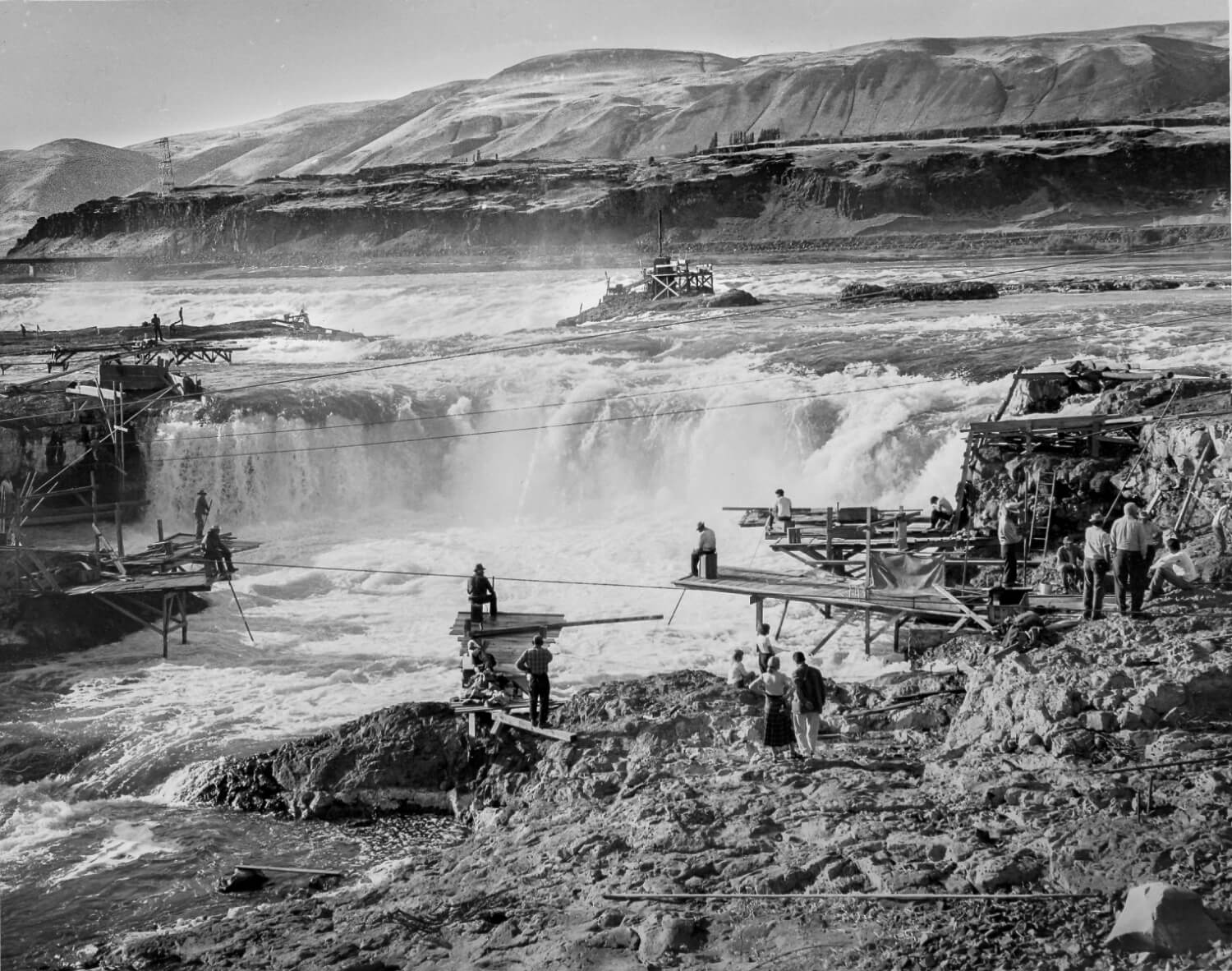
Celilo Falls and its surroundings were continuously inhabited for over 10,000 years. Prior to colonization, the area served as a trading hub for Indigenous communities across western North America. Abundant salmon, steelhead and other fish caught via dip-netting and weirs brought great wealth until the Dalles Dam drowned the falls and adjacent villages in 1957. (Photo: Gladys Seufert via the Oregon Historical Society)
Goldberg stresses that burying 100-mile-long power cables in the riverbed is a concept that Riverkeeper hasn’t grappled with before. And the project’s proponents have yet to file permit applications or environmental impact studies, so her organization doesn’t have the data needed to make an informed decision on whether to back or oppose it.
Based on experience and some preliminary research, however, Goldberg identifies several issues they’ll be looking for. One is the impact from stirring up sediment. She says that while the Columbia is “incredibly beautiful,” it’s by no means “pristine.” In certain parts of the river, sediments are contaminated with PCBs and other toxic pollution — a challenge Kupersmith and Hocker expect to manage by tweaking the cables’ route through the riverbed or even bringing them ashore to bypass certain river segments.
Another potential impact mentioned by Goldberg could come from the electromagnetic fields generated by power cables.Research commissioned by the federal Bureau of Ocean Energy Management looked at magnetic fields emanating from similar transmission cables laid across San Francisco Bay. Those cables helped reduce San Francisco’s dependence on gas-fired power plants.
The study found that the cables had some effects on migratory fish like salmon, which navigate partly by sensing Earth’s magnetic fields. For example, the cables increased the chance that salmon smolts would take a wrong turn that lengthened their journey to the ocean. But it detected no evidence that fish were harmed. Fish appeared to be just as successful at migrating through the bay after the cables were turned on.
Columbia Riverkeeper’s sister organization in New York, which focuses on the Hudson River, evaluated the direct impacts likely to result from PowerBridge’s cable projects there and concluded that delivering cleaner power made it worth the risk. It also backed a much longer submerged cable proposed to bring hydropower from Quebec down the Hudson, but the Ossining, NY-based Riverkeeper recently reversed course on that project. What turned the tide: It concluded the project might encourage provincial utility Hydro-Québec to build additional dams — development that’s opposed by the local First Nations.
Goldberg says the “lengthy history of disproportionate impact of renewable energy on tribal nations” was part of what led Columbia Riverkeeper to oppose the Goldendale Energy Storage Project.
She says the developer came in with “heavy green-energy branding,” but that didn’t make it “clean” from a broader environmental and social justice perspective. Ultimately, the group decided to “work in solidarity with the tribes” to stop that project.
Gov. Inslee has backed the Goldendale project, but last month Washington’s Department of Ecology denied Goldendale a crucial water permit, saying it needed to know more about its impacts on wetlands, streams and groundwater. An equally crucial licensing decision by the Federal Energy Regulatory Commission is pending and could land any day.
Feature image: Standing before a row of the more than 2,900 industrial-scale wind turbines that tap the gales funneling through the Columbia River Gorge, Elaine Harvey poses for a portrait holding a ka’pin, a traditional tool for digging edible and medicinal roots. The turbines supply low-carbon electricity, but Harvey says they’ve also brought fences and ‘no trespassing’ signs to her band’s traditional lands, excluding her people from native plant harvesting areas. At this location, there is only one landowner who allows her band to gather foods for ceremonial and subsistence purposes. (Photo: Leah Nash)

